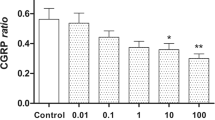Abstract
The effect of the new regulatory peptide Semax (ACTH4–10 fragment) on the electroencephalogram of a healthy person was studied. Semax was administered at 0.5 mg/kg intranasally in 9 volunteers without causing any nervous system pathology. The control group comprised 6 examinees treated in the same way with distilled water. The effect of Semax manifested itself on the electroencephalogram as a boost of biopotential strength in all ranges but especially in that of the α-rhythm, the zonal differences of which were enhanced, without any pathological signs being evident.
Similar content being viewed by others
References
L. R. Zenkov and M. A. Ronkin, in:Functional Diagnosis of Nervous Diseases [in Russian], Moscow (1991), pp. 7–146.
M. A. Ponomareva-Stepnaya, V. N. Nezavibat'ko, L. V. Antonova,et al., Khim.-Farm. Zh., No 7, 790–795 (1984).
D. De Wied, in:Frontiers in Neuroendocrinology, Oxford (1969), pp. 97–140.
Author information
Authors and Affiliations
Additional information
Translated fromByulleten' Eksperimental'noi Biologii i Meditsiny, Vol. 121, No 1, pp. 116–117, January, 1996
Rights and permissions
About this article
Cite this article
Koroleva, M.V., Meizerov, E.E., Nezavibat'ko, V.N. et al. Effect of semax heptapeptide on the human electroencephalogram. Bull Exp Biol Med 121, 108–109 (1996). https://doi.org/10.1007/BF02445721
Received:
Issue Date:
DOI: https://doi.org/10.1007/BF02445721



